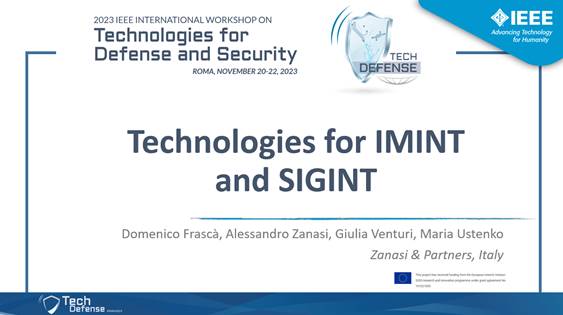
16 Feb Technologies for IMINT and SIGINT
The results of the NOTIONES project were presented in November 2023 at the 2023 IEEE International Workshop on Technologies for Defense and Security (IEEE TechDefense2023) in Rome.
Dr. Paola Fratantoni (Zanasi & Partners) presented the results obtained by NOTIONES about the technologies for Signal Intelligence (SIGINT) and Imagery Intelligence (IMINT) in the conference session 4.1 “Young Researchers Activities in Technologies for Defense and Security – PART I”. The research was published in the form of a conference paper in the IEEE Xplore Digital Library.
This paper is focused on providing up-to-date information about the latest technological developments in IMINT and SIGINT within the Euro-Atlantic community, as well as insights on the relevance and applicability of these technologies for the Intelligence communities (IC) and law enforcement agencies (LEAs).
A critical part of the Intelligence Cycle is collecting raw information needed to produce finished Intelligence through several Intelligence disciplines, including IMINT and SIGINT. Intelligence collection capabilities are often limited by the technological capabilities of the Intelligence agencies.
Historically, less technologically capable Nations have been unable to gain access to information; however, this situation has recently changed. Indeed, there is a proliferation of IMINT and SIGINT technologies and platforms around the world, including even relatively inexpensive and portable Unmanned Aircraft Systems (UASs), which are becoming available to a wide variety of users and organisations.
Commercial Imagery products that approach the quality of Intelligence collection systems are becoming more readily available on the free market. Meanwhile, the developments in artificial intelligence (AI) and image analysis software enable efficient results according to the Intelligence needs.
Due to rapid technological advances, maintaining performance requires continuous and relevant new investments. Recent technology trends, as well as the significant increase in the amount of available information – including irrelevant information – and the complexity of analysis, place demands on the development of Intelligence processes and systems to provide end-to-end information that is relevant and useful to the decision-makers.
The long-term development of personnel skills is also important. Both IMINT and SIGINT provide important sources of Intelligence information in multi-Intelligence platforms. With the aid of current and future AI and ML capabilities, these platforms will conceptually transform and impact traditional methods to process Intelligence.
Future Intelligence will rely on technology, data fusion and analysis of multiple Intelligence sources where IMINT and SIGINT technologies provide an important baseline for the collection of data and information on relevant targets and missions.
The full conference paper can be retrieved here.
Citation: Domenico Frascà, Giulia Venturi, Maria Ustenko and Alessandro Zanasi, “Technologies for IMINT and SIGINT,” 2023 IEEE International Workshop on Technologies for Defense and Security (TechDefense), Rome, Italy, 2023, pp. 165-169, doi: 10.1109/TechDefense59795.2023.




